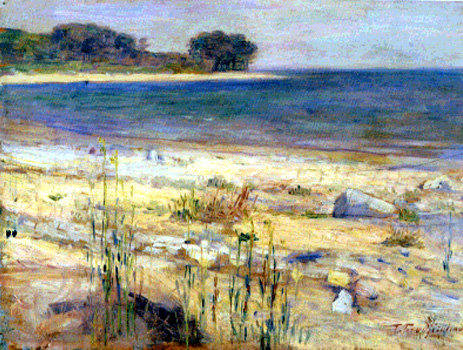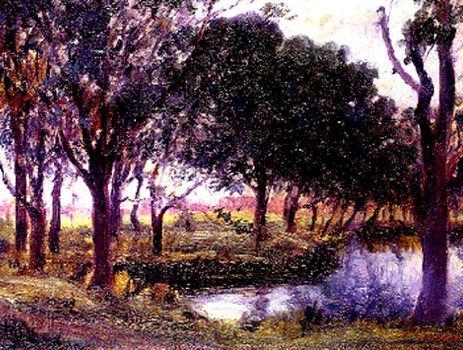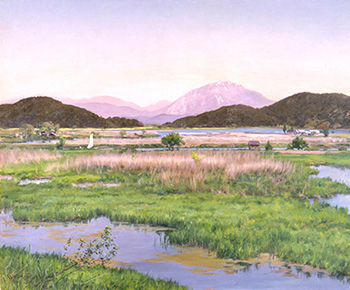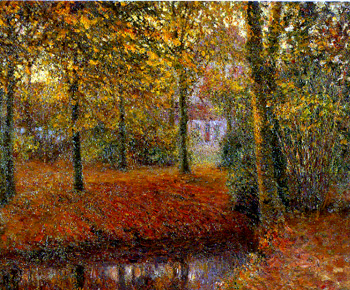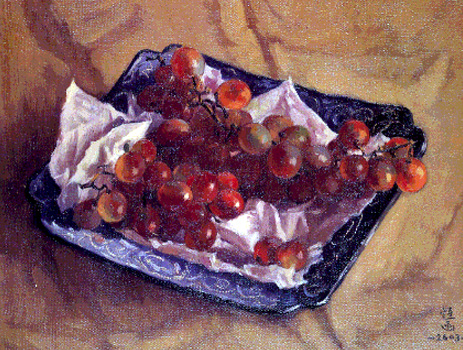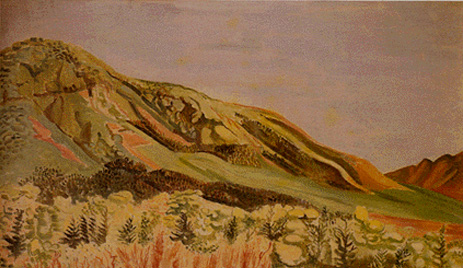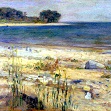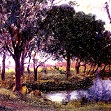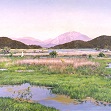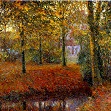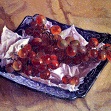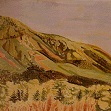Takeji Fujishima was born in September 1867 in the city of Kagoshima as the third son of a retainer of the lord of the Satsuma (Kagoshima) Fief. He entered in 1882 the Kagoshima Middle School, while learning brushwork techniques from Togaku Hirayama, an artist from his hometown. In 1884, Fujishima went to Tokyo, where he became a pupil of Gyokusho Kawabata and studied Japanese traditional painting. However, he later switched to Western-style painting, which he studied under Yukihiko Soyama and Hosui Yamamoto. He exhibited Cruelty under the name of Ikunosuke Shirataki, a younger classmate, at the third Meiji Art Association Exhibition in 1891. This painting garnered high praise from Ogai Mori, novelist and influential art critic. In 1893, Fujishima moved to Tsu City to take up a position as assistant instructor at Mie Prefectural Elementary School. With the firm backing of Seiki Kuroda, Fujishima became an assistant professor of the Tokyo Art School's Western Painting Department when it was established in 1896. Also in that year, he joined the White Horse Society (the Hakuba-kai), which was founded by a group of artists that included Seiki Kuroda, and exhibited his paintings at its annual exhibitions.
In 1905, Fujishima traveled to Europe and studied under Fernand Cormon at the École des Beaux-Arts de Paris in France and Carolus-Duran, President of the Académie de France in Italy. Cormon's speciality was historical paintings, while Duran excelled in portraiture. On his return, in 1910, Fujishima was nominated Professor of Tokyo Art School and became a member of the Imperial Art Academy (the Teikoku Bijutsu-in), as well as a member of the jury for its exhibitions, known in abbreviations at the Tei-ten. In 1937, he received the very first Order of Culture (Bunka Kunsho), a decoration given by the Government to those who have contributed greatly to the development of art, science and other fields of culture, along with Saburosuke Okada. By this time, he was considered an elder statesman among Western-style painting circles.
This painting depicts a sandy beach, with weeds in the foreground, a calm sea in the middle and Enoshima Island in the Background. The painting is an outstanding example of pleinairist technique. According to some records, among the eight oils he exhibited at the third exhibition of the White Horse Society in the autumn of 1898, all except Lakeside depicted coastal scenes. A work entitled Morning beach depicts exactly the same scene as appears in this painting, although the angles are slightly different.
In addition, the signature “T.Foudjishima” at the bottom right is identical to the spelling Fujishima used in his early period, for example in Girl, exhibited at the Meiji Art Association's exhibition in 1895, and Brook in sprint (watercolor), shown at the first White Horse Society exhibition in 1896. Therefore, this work was almost certainly produced in 1898.
Most of the works produced during the early days of the White Horse Society have been lost. Those remaining include only Morning beach, a variant of this work, now in the collection of the Museum of Tokyo National University of Fine Arts and Music, Lakeside, which was shown at the third exhibition, and also at the Paris Expo in 1900, Artificial flower, shown at the sixth exhibition, and a few others. This painting is thus an invaluable example of the work of Takeji Fujishima in his early White Horse Society period.

